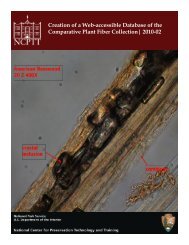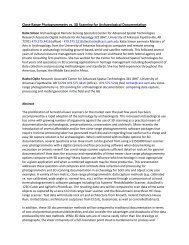Cultural and Natural Resources Potentially Affected by Gulf Oil Spill
Cultural and Natural Resources Potentially Affected by Gulf Oil Spill
Cultural and Natural Resources Potentially Affected by Gulf Oil Spill
Create successful ePaper yourself
Turn your PDF publications into a flip-book with our unique Google optimized e-Paper software.
Map Metadata 07 June<br />
<strong>Oil</strong> Plume Extent Forecast<br />
Source: NOAA/Office of Response <strong>and</strong> Restoration<br />
http://events.arcgisonline.com/arcgis/services/<strong>Gulf</strong>_Coast_<strong>Oil</strong>_<strong>Spill</strong>_Plume<br />
Date Prepared: reported <strong>by</strong> CRGIS as of Monday 07 June<br />
On 18 May, NOAA separated its oil plume extent into separate polygons—an inshore plume <strong>and</strong><br />
an offshore plume. As of 20 May, both plumes were being posted <strong>by</strong> the GIS service. CRGIS has<br />
merged the Uncertainty areas from both plumes <strong>and</strong> differentiated the higher density oil depicted<br />
within the offshore plume. This gives five density classifications within the legend—Heavy,<br />
Medium, Light, Offshore, Uncertainty; previously there were four.<br />
NOAA describes today’s data set as below:<br />
“Forecast location for oil on 07-June-10 at 1200 CDT<br />
Estimates for: 1200 CDT Monday 6/07/2010<br />
Date prepared: 2100 CDT Sunday 6/06/2010<br />
This forecast is based on the NWS spot forecast from Saturday, June 5 PM. Currents were<br />
obtained from several models (NOAA <strong>Gulf</strong> of Mexico, West Florida Shelf/USF, NAVO/NRL,) NC<br />
St/SABGOM). The model was initialized from Sunday morning satellite imagery analysis<br />
(NOAA/NESDIS) <strong>and</strong> Sunday overflight observations. The leading edge may contain tarballs that<br />
are not readily observable from the imagery (hence not included in the model initialization). <strong>Oil</strong><br />
near bay inlets could be brought into that bay <strong>by</strong> local tidal currents.<br />
Onshore (S/SW/WSW) winds are forecast to continue into the coming week at 10 knots or less.<br />
Persistent southerly winds have resulted in northward movement of the slick towards the<br />
Mississippi/Alabama barrier isl<strong>and</strong>s. The westerly component of winds <strong>and</strong> currents has also<br />
resulted in alongshore movement along the Florida Panh<strong>and</strong>le. Trajectories indicate coastal<br />
regions between Dauphin Isl<strong>and</strong> <strong>and</strong> Freeport will continue to experience shoreline contacts<br />
throughout this forecast period. The threat to shorelines in Breton Sound, Ch<strong>and</strong>eleur Sound, <strong>and</strong><br />
the NE side of the Delta is reduced. To the west of the Delta, any remaining floating oil in this<br />
region could come ashore between Timbalier Bay <strong>and</strong> SW Pass.”<br />
Offshore <strong>Oil</strong> Plume Extent Forecast<br />
Server: http://events.arcgisonline.com/arcgis/services<br />
Name: <strong>Gulf</strong>_Coast_Offshore_<strong>Oil</strong>_<strong>Spill</strong>_Forecast<br />
NOAA describes today’s data set as below:<br />
“Forecast location for offshore oil on 07-June-10 at 1200 CDT<br />
Estimates for: Monday 6/07/2010<br />
Date prepared: 1900 CDT Sunday 6/06/2010<br />
Currents were obtained from five models: NOAA <strong>Gulf</strong> of Mexico, NavO/NCOM, NRL/IASNFS,<br />
West Florida Shelf/USF, <strong>and</strong> NC St./SABGOM. Each includes Loop Current dynamics. <strong>Gulf</strong> wide<br />
winds were obtained from the gridded NCEP product. The model was initialized from June 6th<br />
AM satellite imagery analysis (NOAA/NESDIS) <strong>and</strong> NOAA overflight observations from today.<br />
The leading edge may contain tarballs that are not readily observable from the imagery (hence<br />
not included in the model initialization).<br />
Satellite imagery analysis <strong>and</strong> overflight observations continue to indicate b<strong>and</strong>s of sheen to the<br />
SE of the main slick. Today's overflight encountered the feature at a lesser concentration.<br />
Scattered sheens <strong>and</strong> tar balls observed in these regions are being entrained into the northern<br />
edge of the large clockwise eddy (Eddy Franklin) that has pinched off the main Loop Current











